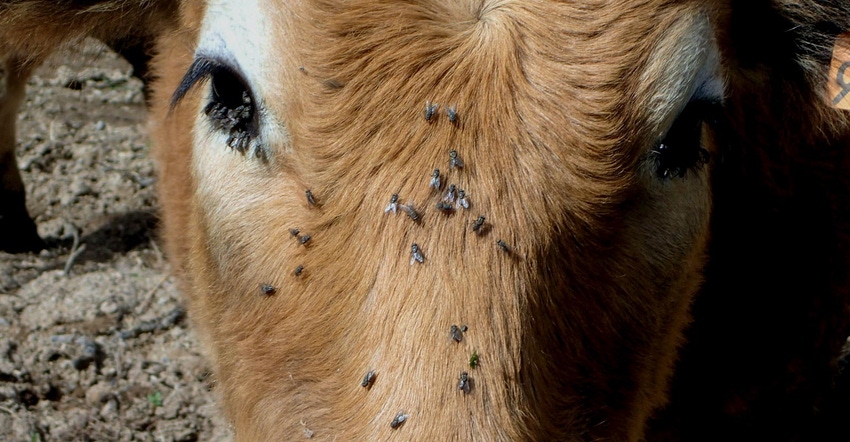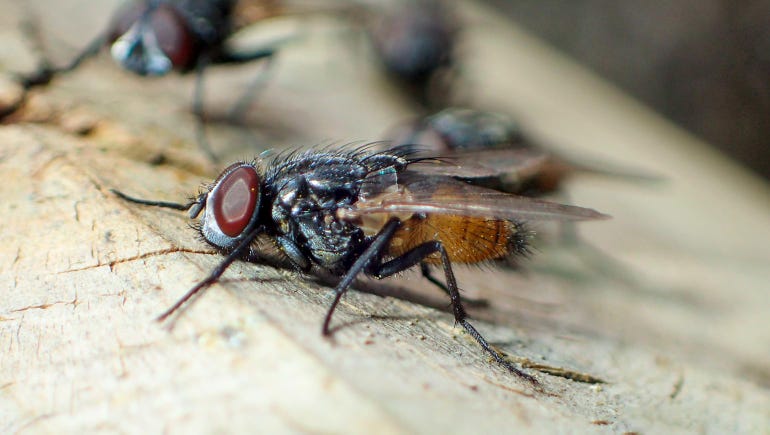
Flies. They are a nuisance for beef cattle. Scott Poock, University of Missouri Extension dairy veterinarian, says beef producers should understand the different types of flies and treatment options to keep cows and calves comfortable this time of year.
Prolonged exposure to flies can reduce beef cattle weight gain and diminish milk production in dairy animals, resulting in financial losses for farmers. Other concerns include mastitis and pinkeye. Poock says early control of flies reduces losses and improves overall herd health.
There are three types of flies that can cause economic damage and discomfort in cattle. The horn fly, face fly and stable fly arrive in the spring, but can linger in hot, humid weather conditions.
“The warmer it is, the faster the fly goes through its life cycle,” Poock says. “In a given summer, several generations can turn over as they multiply.”
Types of flies in cattle
Here are the three types of flies that producers should be concerned about:
Horn fly. Adult horn flies have brownish-gray or black bodies and are shiny and smaller than stable flies. These flies are bloodsuckers and painful to cattle. They tend to gather on a cow’s back in mass. When it gets hot, they move to the underbelly.

GLITTER COWS: Adult horn flies have brownish-gray or black bodies and are shiny, making them almost glisten on a cow’s belly. The body is 3.5 to 5 millimeters long, or about half the size of a housefly.

Poock says that female flies live most of their lives on the cow, leaving only to lay eggs in fresh manure. He says economic damage occurs when there are 100 to 200 flies on the back of one cow. The horn fly completes its life cycle — egg to adult — in less than 20 days when temperatures are warm.
Face fly. These nonbiting flies cluster around an animal’s eyes and mouth. They also gather around open wounds. However, Poock says, these flies despite their name do not stay long on the face. Instead, they spend most of their time on other objects or along waterways, making control more difficult.

ANNUAL PEST: Face flies are about 6 to 8 millimeters in length and have four dark stripes on top of their gray-colored thorax. They look similar to houseflies. Control is important as face flies overwinter as adults in barns and become active again in the spring.

The greatest danger from this fly comes from the development of highly contagious bovine pinkeye, Poock says. Face flies peak in July and August.
Stable fly. You can recognize an adult stably fly by looking at its abdomen and seeing spots. This fly feeds primarily on blood from the legs of the animal by biting, causing the animal to stomp its feet and swish its tail. After feeding, the adult female flies off to lay eggs in manure, moisture and dirt in feedlots.

MISTAKEN IDENTITY: Adult stable flies are similar to houseflies in size and color. The difference is stable flies have seven circular spots in a checkerboard pattern on their abdomens, and houseflies have a random pattern.

The economic threshold is five flies per leg. Poock says stable flies can be reduced by keeping pastures mowed and feeding sites free of residue.
Time for fly control measures
Adult flies are “just the tip of the iceberg,” Poock says. “When you see adults, there are many, many more at the other stages.”
There are several control methods. Travis Meteer, University of Illinois Extension commercial agriculture educator, outlined a few for farmers to consider:
Fly tags. These are a popular choice. However, farmers need to rotate active ingredients or types of insecticide to thwart resistance. Remove all old tags immediately after the season. Most fly tags provide good coverage for only 30 to 60 days. So, fly tags should be one part of your fly control plan, not the entire plan.
Oilers and dust bags. These should be used in areas where cattle are required to go under them in a gateway, around a mineral feeder, or any other high-use area. Success of this control method depends on keeping the oilers and dust bags containing insecticide. But they are a great low-labor tool to reapply fly control.
Sprays. If you want to immediately kill flies, this is the most effective method, but this is a one-time treatment as sprays do not provide much residual control. Farmers must reapply frequently to control high fly loads. This adds labor for the farmer and sometimes stress to the animal. Some sprays do have residual, but only for one to two weeks. Remember to wear protective clothing and eye protection, and do not spray near feed and water.
Biological. This control method calls for fly parasites. These parasites attack fly pupa, preventing flies from hatching. The parasitic wasp has a lifespan of 18 to 21 days and should be distributed throughout the fly-breeding season.
Feed additives. This prevention method includes insect growth regulators, or IGR, that can be fed through minerals or tubs. It’s designed to break the life cycle of the fly. Start feeding IGR at least two weeks before fly season. While the method brings with it little labor for the farmer and low stress on the animals, it is costly.
As always, Poock says, follow label instructions and use safety precautions, such as wearing gloves.
For more information, visit the MU Extension livestock or dairy specialist in your area.
University of Missouri Extension provided information for this article.
About the Author(s)
You May Also Like






